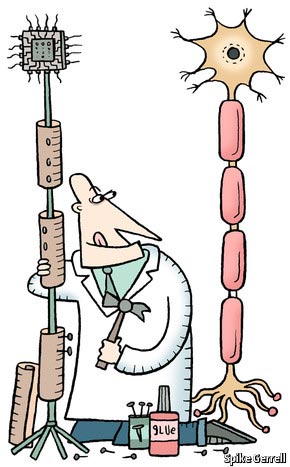
credit : Spike Gerrell for the Economist
Neuromorphic computing is a concept developed by Carver Mead, describing the use of very-large-scale integration (VLSI) systems containing electronic analog circuits to mimic neuro-biological architectures present in the nervous system. Carver Mead is a key pioneer of modern microelectronics.
Today the term neuromorphic is used to describe analog, digital, and mixed-mode analog/digital VLSI and software systems that implement models of neural systems. Neuromorphic computing is a new interdisciplinary discipline that takes inspiration from biology, physics, mathematics, computer science and engineering to design artificial neural systems and autonomous robots, whose physical architecture and design principles are based on those of biological nervous systems.
The goal is to make computers more like brains and to design computers that have features that brains have and computers do not have up to now :
- low power consumption (human brains use about 20 watts)
- fault tolerance (brains lose neurons all time without impact)
- lack of need to be programmed (brains learn and change)
An important property of a real brain is that each neuron has tens of thousands of synaptic connections with other neurons, which form a sort of small-world network. Many neuromorphic chips use what is called a cross-bar architecture, a dense grid of wires, each of which is connected to a neuron at the periphery of the grid, to create this small-world network. Other chips employs what is called synaptic time multiplexing.
The Economist published a few days ago a great article “Neuromorphic computing – The machine of a new soul” with illustrations from the London-based illustrator Spike Gerrell.
Some neuromorphic computing reletad projects are listed below :
- Human Brain Project (HBP)
- SpiNNaker brain simulation machine; part of HBP
- BrainScaleS – Neuromorphic processors , FACETS, Spikey ; parts of HBP
- Brain Activity Map Project
- DARPA SyNAPSE Program
- Neurogrid – Brains in Silicon
- CogniMem
- iLab Neuromorphic Vision C++ Toolkit
- Beobots
Neuromorphic computing is dominated by European researchers rather than American ones. The following links provide additional informations about neuromorphic computing related institutions and topics :
- Neuromorphic Cognitive Systems – Institute of Neuroinformatics – UZH – ETH Zurich; goal : autonomous cognitive systems
- Institute of Neuromorphic Engineering (INE)
- HRL Laboratories
- Brain Corporation
